Part of a series of articles titled Landmark Highlights.
Previous: Landmark Highlights 2022
Next: Landmark Highlights 2020
Article


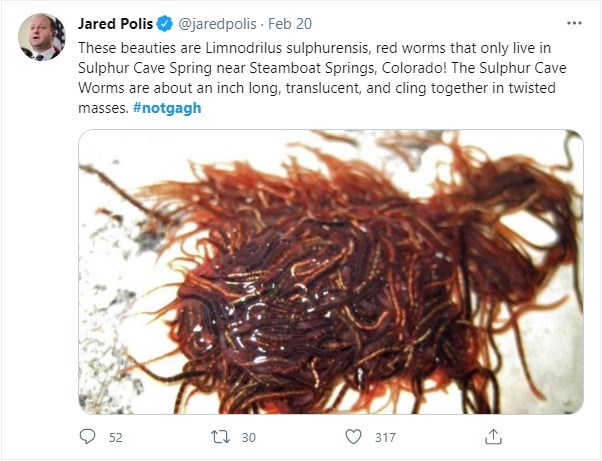
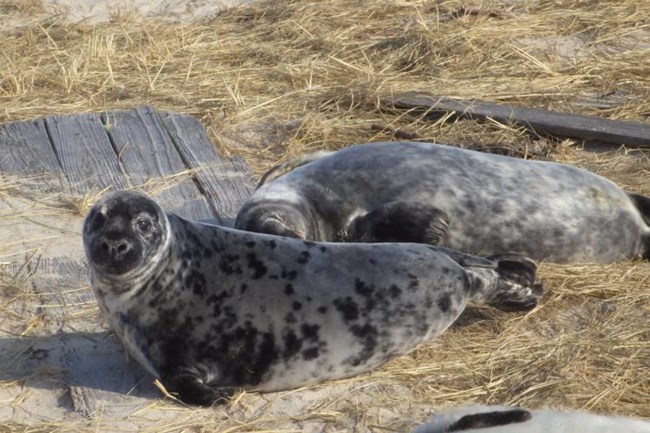
🙤 Muskeget Island NNL, off the western end of Nantucket Island, Massachusetts has been at the center of gray seal (Halichoerus grypus) recovery in U.S. North Atlantic waters. In the 50 years since passage of the Marine Mammal Protection Act in 1972, the seals have gone from nearly absent in U.S. waters to now 3,000 to 4,000 pups born annually on Muskeget. It is the oldest and largest pupping colony in the U.S. with a 30-year data set demonstrating a steady and significant increase in gray seals. Informally called "horse heads" due to their large, curved noses, female gray seals weigh in at 300-400 lbs and males are up to 800 lbs. Travelling from Canadian waters, the seals have reoccupied historical habitat and established multiple, growing pupping colonies off the coasts of Maine and Massachusetts. Muskeget has proven to be an attractive and successful pupping site, likely due to its isolation and distance from the mainland and constantly shifting shallow shoals that provide a buffer from disturbance and predators. Monitoring of gray seal recolonization and recovery in the U.S. began on Muskeget in 1988 and now includes nine known pupping colonies.
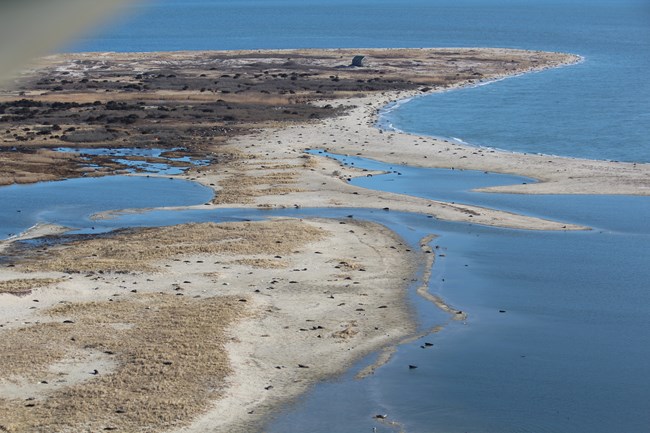
NOAA's Northeast Fisheries Science Center and its partners study the abundance, distribution, and health of gray seals along the New England coast. Conducting their field work in January, estimated to be the peak of the December to February gray seal pupping season, researchers employ satellite and acoustic tags to monitor dispersal and survival and drones to assess seal distribution and abundance. They also routinely take to the air by plane to conduct aerial surveys from the Canadian border to Long Island, NY to monitor recolonization of habitats and estimate range-wide population numbers. Results of their work suggest that the healthy source population from Canada, the species' propensity for dispersal combined with protection from harassment or hunting, and the availability of habitat on Muskeget and other New England islands, has led to recovery of the gray seal in U.S. North Atlantic waters.
Designated an NNL in 1980, Muskeget Island is part of the terminal moraine marking the maximum extent of the last glacial ice sheet to reach the northeastern coast. It is the only known locality where the Muskeget beach vole (Microtus breweri) is found and is one of the southernmost breeding areas for gray seal. The island's private and municipal owners provide stewardship to keep Muskeget forever wild. More information about gray seal recovery and monitoring is available at NOAA's website (Researchers Return to Study Gray Seal Pups in New England | NOAA Fisheries; Aerial Surveys Monitor Growing Gray Seal Populations off the Northeastern United States | NOAA Fisheries) and in a 2020 Journal of Mammalogy article (Rates of increase in gray seal (Halichoerus grypus atlantica) pupping at recolonized sites in the United States, 1988–2019 | Journal of Mammalogy | Oxford Academic (oup.com)).
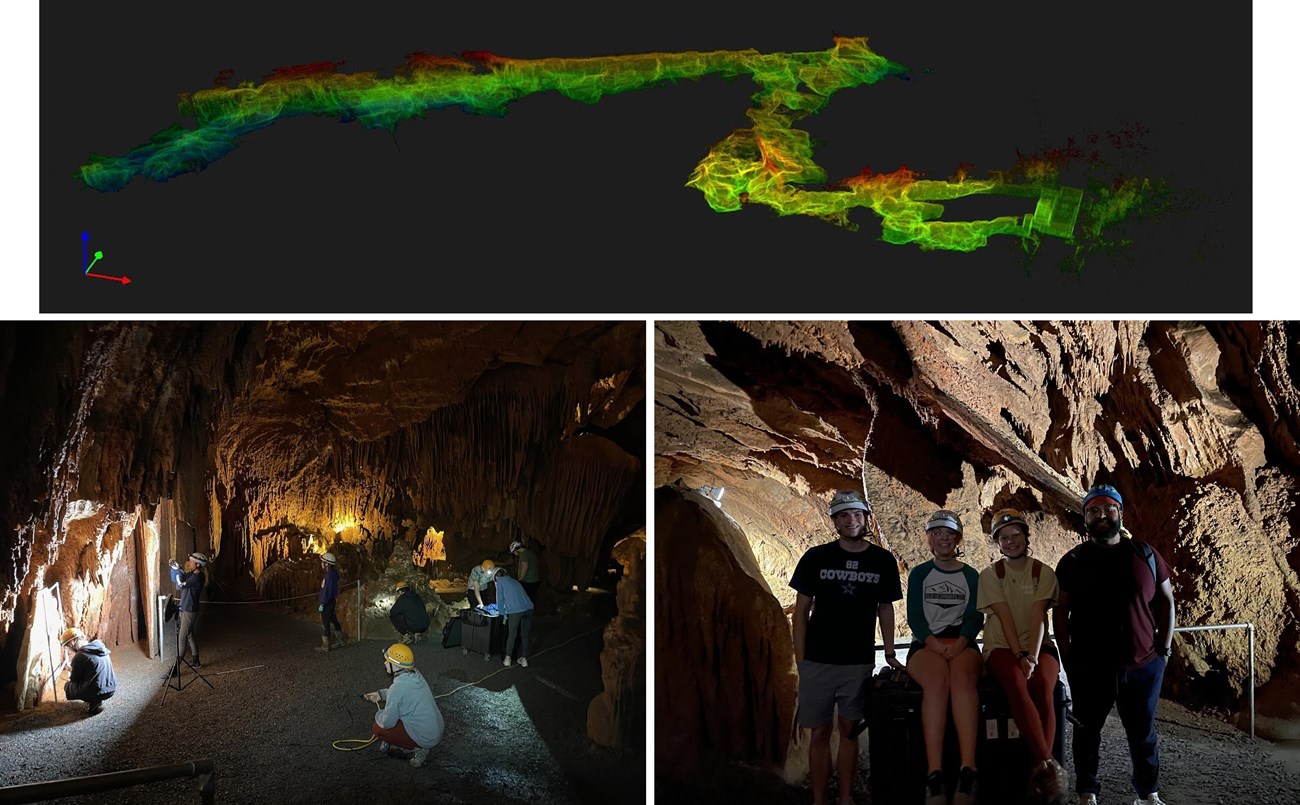
🙤 Grand Caverns, located in Augusta and Rockingham Counties, Virginia, was designated an NNL in 1973 for its unique cave features including shield formations, draperies, flowstone, stalactites and stalagmites. The town of Grottoes manages the cave, and in April 2021 they partnered with Dr. Angel A. Garcia Jr. and his students from James Madison University (JMU) to create a 3D map of the cave. Using a handheld LiDAR scanner, the team was able to quickly and accurately capture and review data without the need for GPS or other complicated setups. The resulting 3D point cloud is being used to help measure speleothems, monitor the human impact on the cave, as well as print 3D models of the cave, providing an awesome way to connect people with this amazing, complex underground world. This project also provided a fantastic hands-on opportunity for the JMU undergraduate students to learn and test out cutting-edge equipment, and see first-hand the value of the resulting data for management, education and inspiration.
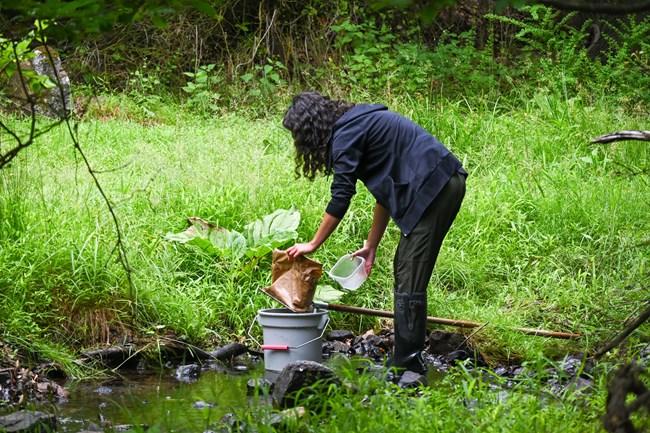
🙤 Friends of Garret Mountain Reservation (FoGMR) and Passaic County Parks and Recreation sponsored a Bioblitz at Garret Mountain Reservation (part of the Great Falls of Paterson-Garret Mountain NNL) and nearby Rifle Camp Park. For 24 hours on June 11-12, citizen-scientists recorded as many species as possible using iNaturalist and eBird, documenting over 200 total species, including 51 bird species. Expert-led walks and other educational and wildlife-themed activities were offered by FoGMR, Torrey Botanical Society, Montclair Bird Club, Lokai Rose, and the NJ Watershed Ambassador. Bioblitz data will inform future management plans and provide an ecological snapshot to monitor changes over time. Recommendations included posting no-mowing areas where milkweed was detected, enhancing turtle habitat, restoring over-browsed forest understory, and removing documented non-native plant species. Several areas were identified as hot spots or priority areas for protection, including Barbour's Pond and Slippery Rock Brook, the latter found to host a great diversity of aquatic macroinvertebrates. Full Bioblitz results are available on the iNaturalist project page at: https://www.inaturalist.org/projects/garret-mountain-reservation-rifle-camp-park-n-j-bioblitz-2021
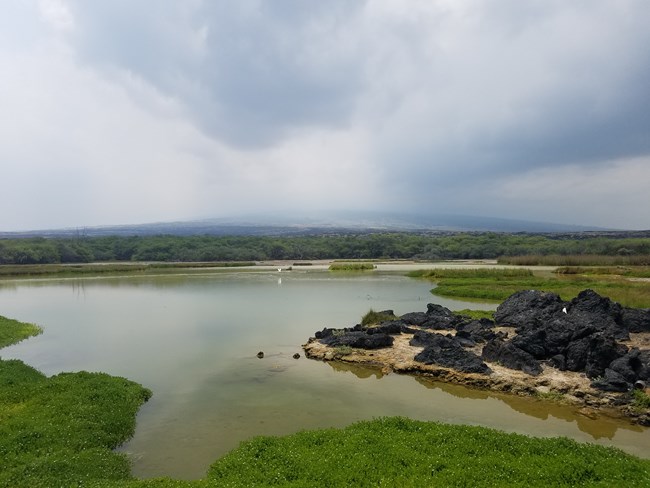
🙤 Makalawena Marsh, located on the Island of Hawaiʻi north of Kona, was designated an NNL in 1972 as one of two remaining ponds in Hawaiʻi that support a resident population of endangered, nonmigratory Hawaiian stilt. ‘Ōpaeˋula pond (also referred to as Kapoʻikai pond), is also a principal nesting site for the unique nonmigratory Hawaiian coot and the only known breeding site for the black-crowned night heron on the Island of Hawaiʻi. The site is also rich in cultural resources, including the wall of an ancient Hawaiian fishpond that remains beneath the surface of the ‘Ōpaeˋula pond. Kamehameha Schools, who own and manage the site, are currently undertaking a long-term planning process to create an Integrated Resources Management Plan (IRMP). The IRMP will provide a road map to balance land management, stewardship, and educational activities, while revitalizing and strengthening the site’s historical and cultural resources and identity. Seeking public input and greater clarity of the regulatory permitting requirements early in the planning process has enabled the planning team to shift and adapt where needed, such that the final result will be a plan that is both implementable and endorsed by all stakeholders. Protection and conservation of natural and cultural resources remain a cornerstone of the IRMP and as the planning process moves forward, the plan continues to emphasize the importance of the nationally significant values for which Makalawena Marsh was designated an NNL.
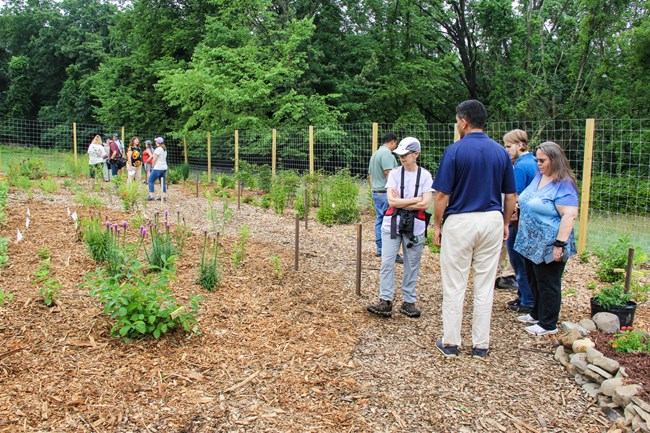
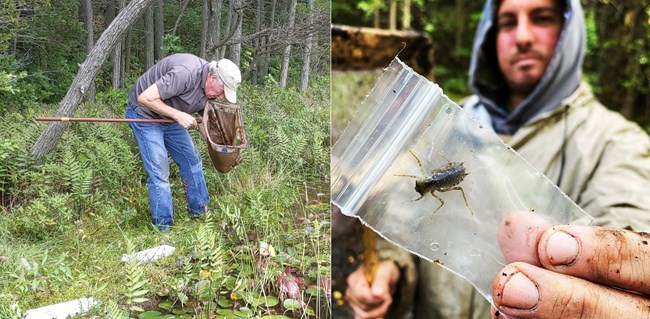
🙤 2021 marked the fifth year NNL sites have participated in the Dragonfly-Mercury Project. Appreciation goes out to staff and volunteers at Bear Meadows Natural Area, PA, East Inlet Natural Area, NH, Battle Creek Cypress Swamp, MD, Fort Worth Nature Center and Refuge, TX, Lilley Cornett Woods, KY, and Ell Pond, RI for their time and efforts to contribute important data points to this long-term, collaborative project. And a special shout-out to Bear Meadows Natural Area and East Inlet Natural Area that have participated in all five years! All years of dragonfly mercury summary data are now available at https://wim.usgs.gov/geonarrative/dmpdatadashboard/ and additional project information, including an interactive story map, can be found here https://www.nps.gov/articles/dragonfly-mercury-project.htm.
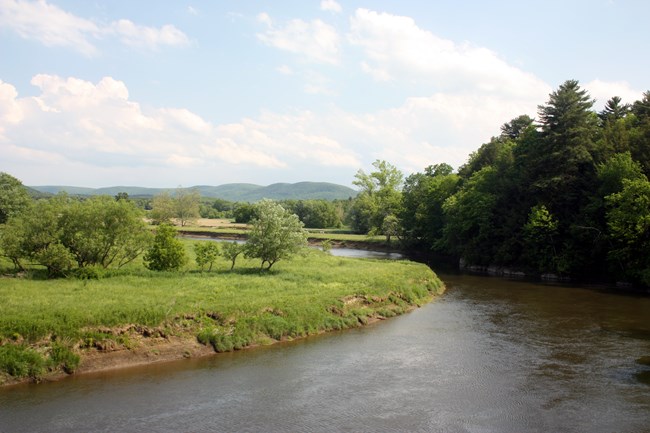
🙤 Pledging allegiance to support pollinators and their habitats, Bartholomew's Cobble NNL, MA joined Housatonic Heritage's Pollinator Resolution in spring 2021. The Upper Housatonic Valley in CT and MA is among a number of National Heritage Areas leading the Operation Pollination initiative in partnership with the National Park Service (NPS). Through public-private partnerships, education, research, and on the ground actions, Operation Pollination aims to collaboratively and strategically protect pollinator species and enhance their habitat. The Trustees of Reservations expressed their commitment to maintain and improve native and host plant diversity, provide nesting and overwintering habitats, and conduct programs and outreach celebrating pollinators and educating visitors at Bart's Cobble and other preserves. Designated in 1971, Bartholomew's Cobble is considered the greatest natural concentration of fern species in the country and hosts a remarkable diversity of habitats and flora. For more on Operation Pollination or Bartholomew's Cobble, please visit: Operation Pollination - Housatonic Heritage, Bartholomew's Cobble - The Trustees of Reservations, National Heritage Areas and Partners Embrace “Operation Pollination” (U.S. National Park Service) (nps.gov)
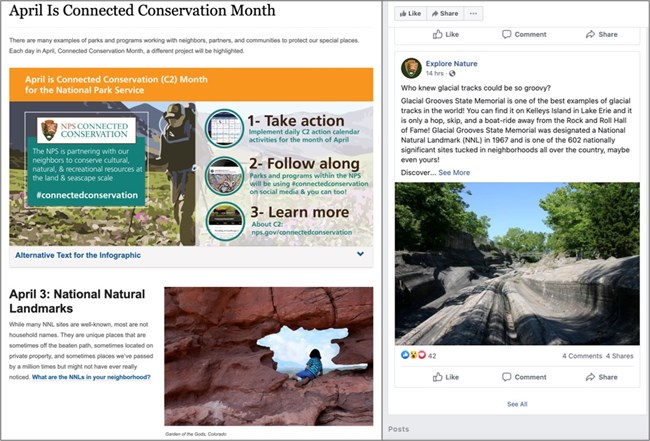
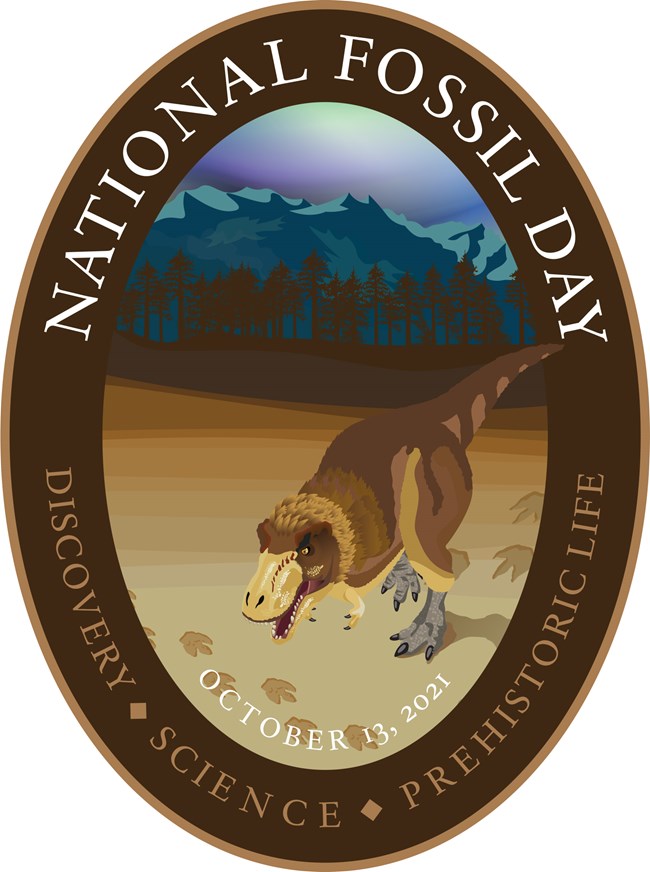
National and International celebrations of the Earth’s various diverse natural features provide a great opportunity to connect sites across the landscape and for sites to share about those resources with their local communities.
National Fossil Day (NFD) has been held every October for 12 years running. Hosted by the NPS and the American Geosciences Institute, the annual event promotes the scientific and educational value of paleontology and the importance of preserving fossils for future generations. The NNL Program was excited to further it’s partnership with the NPS’ Paleontological Program by providing more web presence about paleo resources at NNLs, alongside information about such resources at units of the national park system, providing a more holistic educational opportunity for web visitors. A couple of these new and updated web pages can be found here: https://www.nps.gov/subjects/fossils/dinosaurs.htm, https://www.nps.gov/subjects/fossils/index.htm.
NNL Program staff reached out to owners and managers at nearly 60 NNL sites that contain significant paleo resources to share these websites and paleo educational materials, as a way to encourage and support participation by NNLs in this nationwide celebration. Landmark sites can visit this website https://www.nps.gov/subjects/fossilday/get-involved.htm for ideas on how to engage in 2022. Reach out to your regional NNL coordinator for paleo materials or to share your NFD stories.
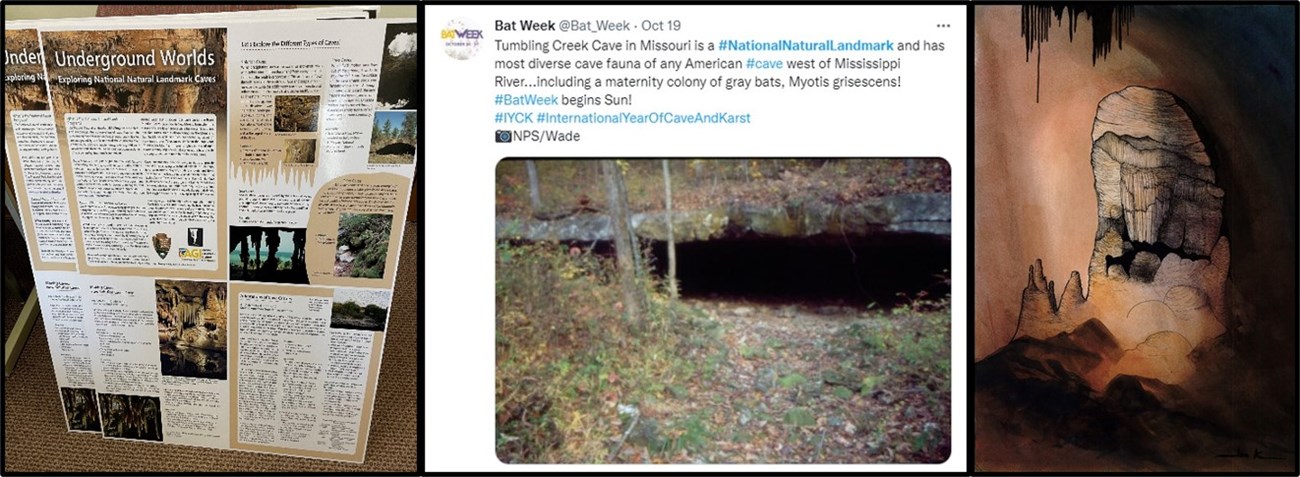
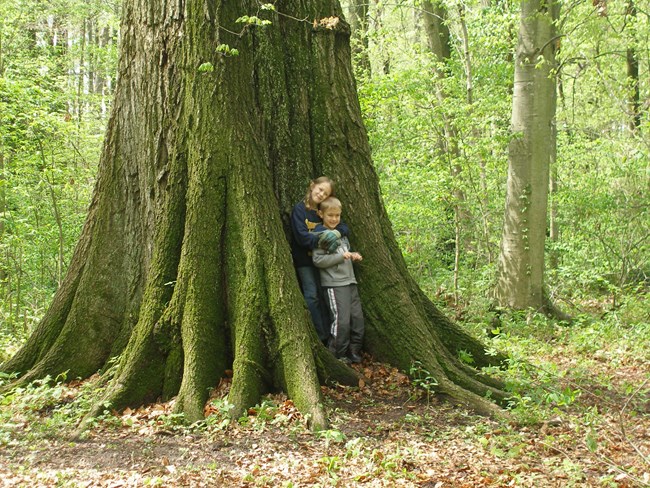
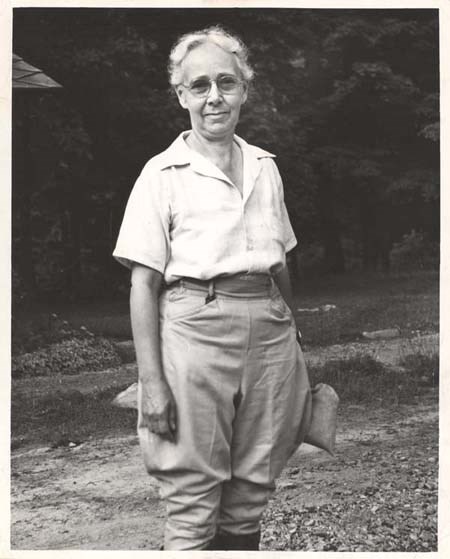
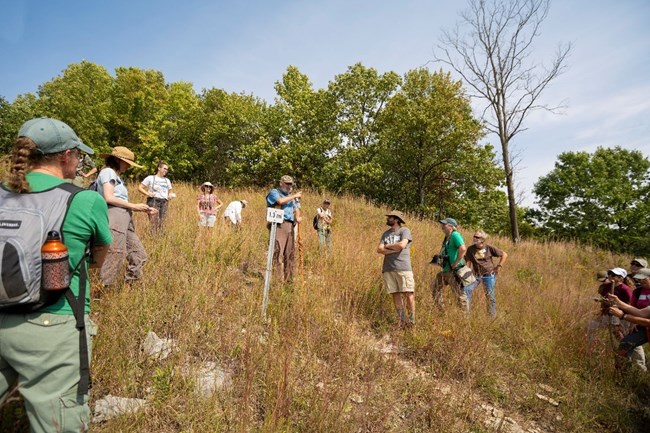
🙤 Fults Hill Prairie Nature Preserve, managed by the Illinois Department of Natural Resources, is a high quality, undisturbed loess hill prairie situated near the Mississippi River in southwest Illinois. This site was established as a nature preserve in 1961 and designated an NNL, 25 years later, in 1986. To mark the 50th anniversary of the preserve’s establishment and five decades of protecting and restoring this special landscape, community members and supporters gathered in celebration on October 9, 2021. Superintendent Chris Collins, from nearby Ste. Genevieve National Historical Park, joined representatives from the Illinois Nature Preserves Commission and other conservation partners to mark the occasion. Representing the National Park Service and the NNL Program, Superintendent Collins spoke about the importance of conserving and recognizing places like Fults Hill Prairie Nature Preserve. The public enjoyed tours of the site where past and present staff discussed the natural history, management, and restoration efforts. The event was a great opportunity for the public and local conservation partners to connect and hear about the work underway at the site.
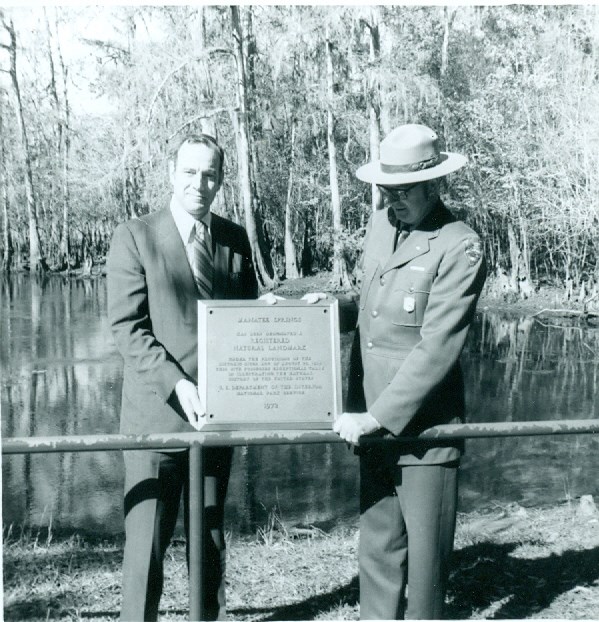
🙤 Twenty-two sites were designated as NNLs in 1971 and thus celebrated their quinquagenary anniversary in 2021. All sites were designated by Secretary of the Interior Rogers C. B. Morton, 9 of them in mid-June and the remaining 13 in early October of that year. Happy 50 years!
|
Hawaii |
Kanahā Pond |
|
Kentucky |
Lilley Cornett Woods |
|
Missouri |
Grand Gulf |
|
New Hampshire |
Franconia Notch |
|
New Jersey |
Riker Hill Fossil Site |
|
Oregon |
Crown Point |
|
Tennessee |
Savage Gulf |
|
Washington |
Nisqually Delta |
|
Washington |
Point Of Arches |
|
Alabama |
Shelta Cave |
|
Colorado |
Garden Of the Gods |
|
Connecticut |
Bartholomew's Cobble |
|
Florida |
Ichetucknee Springs |
|
Florida |
Manatee Springs |
|
Florida |
Rainbow Springs |
|
Florida |
Silver Springs |
|
Missouri |
Maramec Spring |
|
Texas |
Devil's Sinkhole |
|
Texas |
Enchanted Rock |
|
Texas |
Ezell's Cave |
|
Texas |
Longhorn Cavern |
|
Texas |
Natural Bridge Caverns |
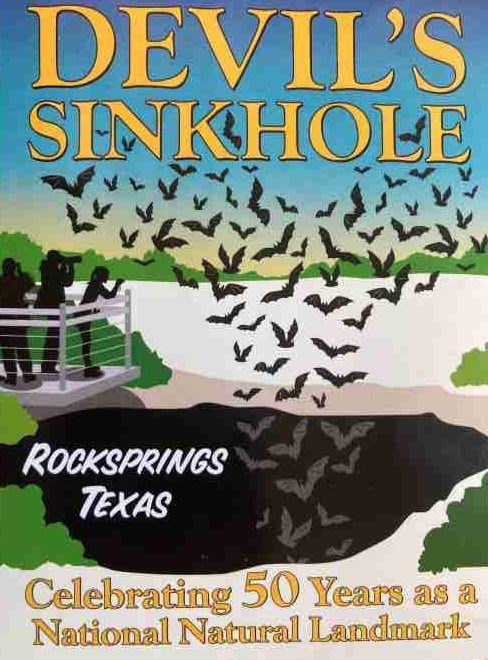
🙤 The five Texas NNLs designated in 1971 celebrated their golden anniversaries over an October weekend full of festivities held at Devil’s Sinkhole in Rocksprings, TX. Sonora Caverns, another central Texas NNL, attended the event, as did representatives from six nearby state parks. Over 500 people enjoyed presentations from cave and karst experts such as Dr. George Veni, Nyta Brown, and Master Naturalists from Kerrville and Fredericksburg. These professionals told the stories of the Hill Country in central Texas where ancient shallow seas deposited shells and bones, which turned into the limestone that contains thousands of caves across the region. These caves and other subterranean features provide shelter to tens of millions of bats. Fortunately, the summer’s persistent rain held off during the two-day event so attendees could enjoy the spectacle of millions of bats exiting Devil’s Sinkhole and flying off into the sunset. The San Antonio Astronomy Association concluded the commemoration with stargazing on the second night. http://www.ntxe-news.com/artman/publish/article_126269.shtml
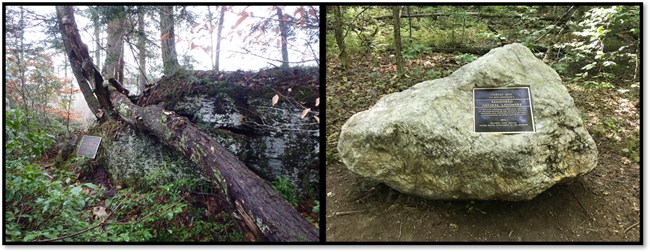
🙤 Despite the uncertainty surrounding its exact location, the bronze plaque at Hawley Bog NNL was rediscovered along a former, overgrown roadway near the bog. Easily removed from the large boulder upon which it was mounted, the plaque was shipped to the metal foundry for restoration. With a refurbished plaque in-hand, a quarzite boulder supplied by the Town of Hawley, and funds provided by The Nature Conservancy (TNC) and Five Colleges, Inc., the plaque was successfully mounted in the fall of 2020 in a new and prominent location along the main trail into the bog; once again proclaiming to all visitors the site’s significance and special status as an NNL. The unique northern sphagnum-heath bog, situated adjacent to the historic Hawley Town Common, is TNC's most visited property in Massachusetts. https://www.nature.org/en-us/get-involved/how-to-help/places-we-protect/hawley-bog-preserve/?redirect=https-301
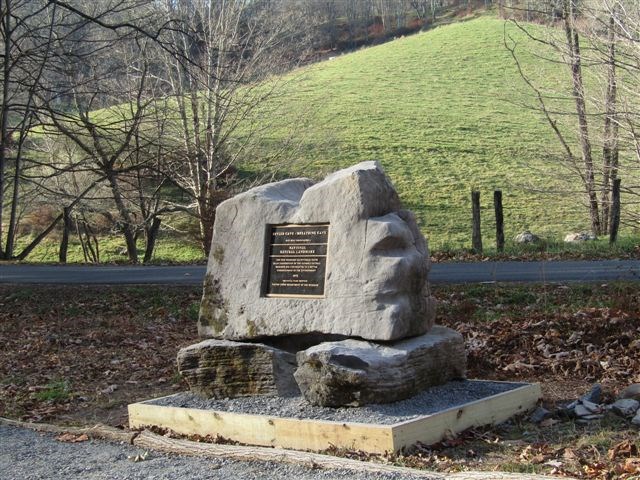
🙤 Butler Cave-Breathing Cave, located in Virginia, includes two major cave systems that contain a 40-foot waterfall, a natural bridge, unusually fine “floating” crystalline formations, and an underground lake. Although designated an NNL in 1973, it wasn’t until 2021 that a bronze NNL plaque was displayed at the site. Along with the newly displayed plaque, the Butler Cave Conservation Society, who own and manage the cave, have recently completed other above-ground projects including construction of a short Karst Educational Trail and kiosk that provides information about the cave, trails and the NNL designation.
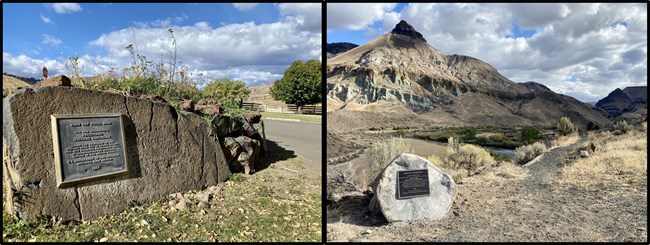
🙤 John Day Fossil Beds was designated an NNL in 1966 in recognition of its nearly continuous 45-million-year fossil record representing most of the Cenozoic Era, the “Age of Mammals and Flowering Plants.” When the NNL was established, the commemorative bronze plaque was affixed to a large boulder on the grounds of the Cant Ranch, a working ranch at the time. This site is now a National Register property within John Day Fossil Beds National Monument (JODA), administered by the National Park Service. While the ranch offers visitors the opportunity to experience eastern Oregon’s ranching heritage, the site of the original plaque is hard to find and has no relation to the significant resources behind the NNL designation.
According to the principles of Freeman Tilden, who is often considered the father of heritage interpretation, “Any interpretation that does not somehow relate what is being displayed or described to something within the personality or experience of the visitor will be sterile.” Put simply, location matters. Inspired by this principle, and a desire to better interpret the significance of the NNL, park staff sought a new plaque location. However, as the original plaque is now a contributing historic feature of the ranch, the park was provided with a duplicate bronze plaque in 2021. The new plaque was installed at the end of the Sheep Rock Overlook Trail that showcases the NNL in a manner that would presumably make Freeman Tilden proud were he still alive today. The NNL plaque is now also situated nearby a plaque placed in 1954, honoring the contributions of the 19th-century geologist, naturalist, and natural history professor Thomas Condon, who first recognized the international significance of the fossil beds. Together, these two plaques memorialize the significance of the natural resources at JODA and the people who advocated for its protection and scientific research.
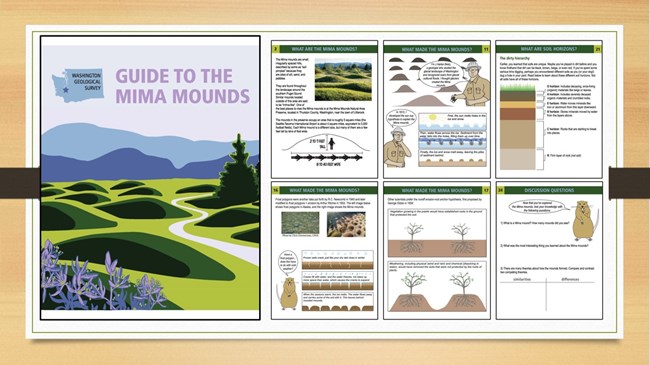
🙤 Mima Mounds NNL, located in western Washington, was established as a state Natural Area Preserve in 1976 to protect the rare examples of a landform known as Mima mounds. These unusual geological features are small, irregularly spaced hills, ranging in size from barely perceptible to up to seven feet tall and are found throughout the southern Puget Sound. Many hypotheses exist on what exactly created the Mima mounds, and the Washington Department of Natural Resources recently created a new educational guide exploring the various theories and illustrating the possibilities in a fun, creative manner. The booklet can be explored and downloaded here https://www.dnr.wa.gov/publications/ger_mima_mounds_booklet.pdf.
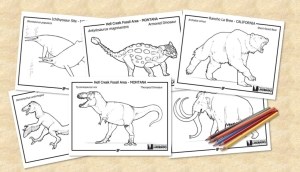
🙤 Across the country, there are many NNLs that contain significant fossil evidence of ancient times. To connect younger audiences with the wonders of these prehistoric species, the NNL Program recently teamed up with the NPS Paleontology Program to develop prehistoric life coloring pages. Some of these include world-famous places like Rancho La Brea in California where natural asphalt tar pits entrapped Pleistocene animals in their quest for fresh water, and Ghost Ranch in New Mexico where well-preserved skeletons of the Triassic dinosaur Coelophysis have been exposed. Other sites contain evidence and fossils of ancient coral reefs, woolly mammoths, prehistoric bears, and more. These coloring pages are available for download at https://www.nps.gov/articles/000/nnl-prehistoric-life-coloring-pages.htm. Additional coloring pages representing prehistoric life from National Park System units are also available for download here https://www.nps.gov/subjects/fossils/coloring-book.htm.
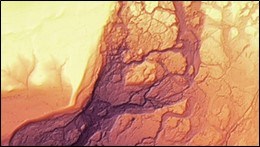
🙤 The Washington State Department of Natural Resources, Geological Survey recently released a virtual guide to Washington’s geologic heritage called Washington 100. Offering 100 places to experience the state’s geology up close, the site entices visitors to explore the state’s scenic landscapes “along its craggy Pacific coastline, across its alpine crest, and into its eastern scablands.”
Ten of the 100 sites presented are also NNLs, capturing over half of the state’s 18 landmark sites. Organized into seven provinces within the state, these are the NNLs that help tell the state’s geologic story:
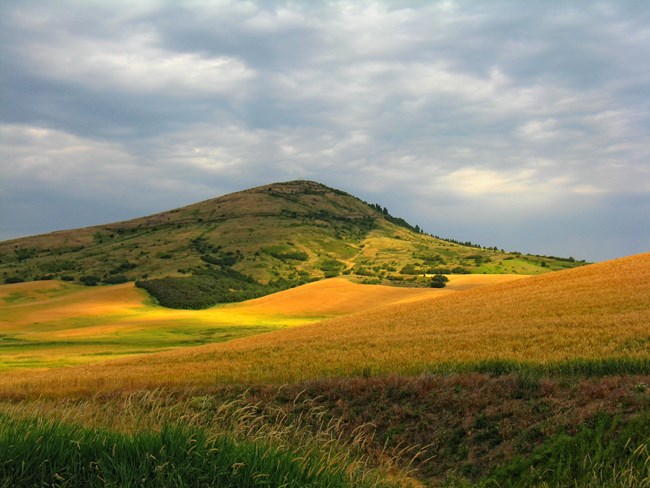
Within the Columbia Basin:
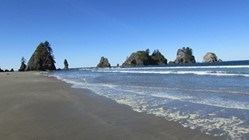

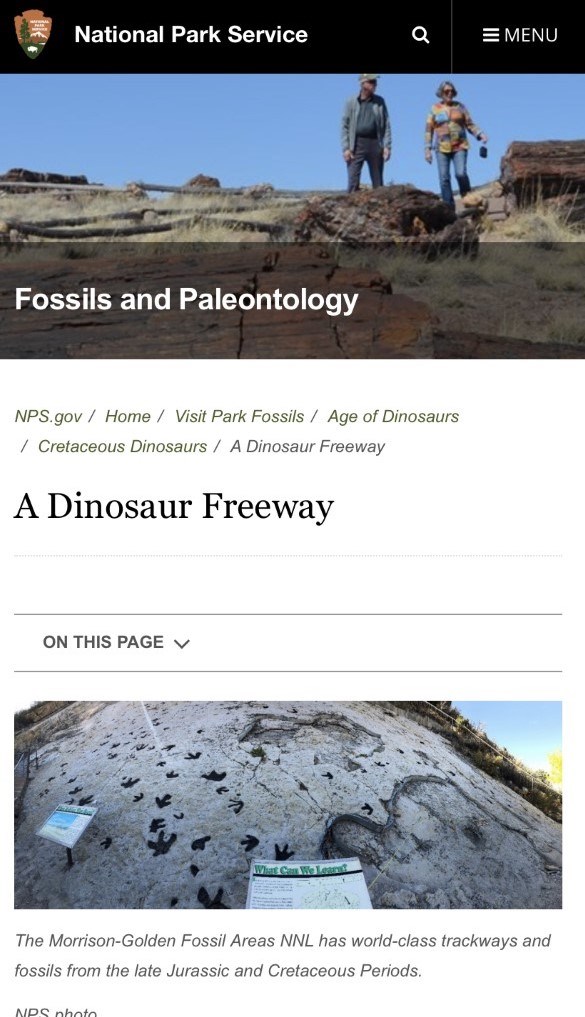
🙤 Important paleontological resources, and the stories associated with their discovery and importance to science, are not only found within units of the National Park System, but also at designated NNL and National Historic Landmark (NHL) sites. Thus, the NPS has been working to provide a more integrated online learning experience.
Unveiled for National Fossil Day 2021, the Age of Dinosaurs website features basic dino-related information, insights into the time periods dinosaurs roamed the Earth, and provides the portal through which information about dino-related park, NNL and NHL sites can be accessed. For example, when exploring the webpages linked to each of the three Mesozoic Periods (Triassic, Jurassic and Cretaceous), online visitors can discover the NNL Program’s Telling the Dinosaur Story 3-part video series, a listing of NNLs featuring fossils from that time period, as well as any NHL sites designated for their tie to the science-story.
Two dinosaur trackway NNLs, Morrison-Golden Fossil Areas, CO and Dinosaur Trackway, CT are prominently featured on the Dinosaur Freeway page, and some of the aforementioned NNL fossil coloring pages appear in the NPS' set of Prehistoric Life in National Parks & NNLs Coloring Pages. NNL content is woven throughout the website; on the Dinosaurs in the Fossil Record, Famous Dinosaurs, Where Dinosaurs Roamed and other pages. The latter including a nation-wide map of both National Historic and National Natural Landmark dinosaur fossil sites.
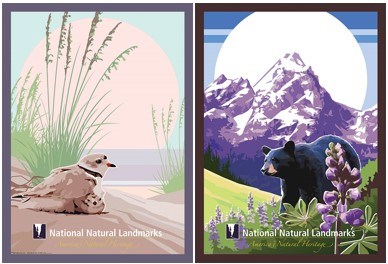
🙤 The NNL Program was pleased to release the fourth set of artwork pieces in 2021, which illustrate seashores and mountains. Along with the illustrations of caves, waterfalls, swamps and prairies, these eye-catching graphic pieces visually portray the beauty and broad diversity of outstanding biological and geological features represented at NNL sites across the country.
These works, along with information about the natural feature and places where they can be found, are included on the NNL Program website. Learn more...
🙤 Seven NPS employees are committed to advancing the work of the NNL Program and supporting landmark owners.
Adrienne Lindholm, (AK)
Carolyn Davis, (AL, FL, GA, KY, MD, MS, NC, Puerto Rico, SC, TN, VA, VI, WV)
Deb DiQuinzio, (CT, MA, ME, NH, NJ, NY, PA, RI, VT)
Jeff Orlowski, (AR, AZ, CO, KS, MT, ND, NE, NM, OK, SD, TX, WY, UT)
Laurie Lee Jenkins, (Am. Samoa, CA, Guam, HI, ID, NV, OR, WA)
Leo Acosta, (IA, IL, IN, MI, MN, MO, OH, WI)
Heather Eggleston, Program Manager
Full contact information can be found on the NNL Program website nps.gov/orgs/1211/contactus.htm.
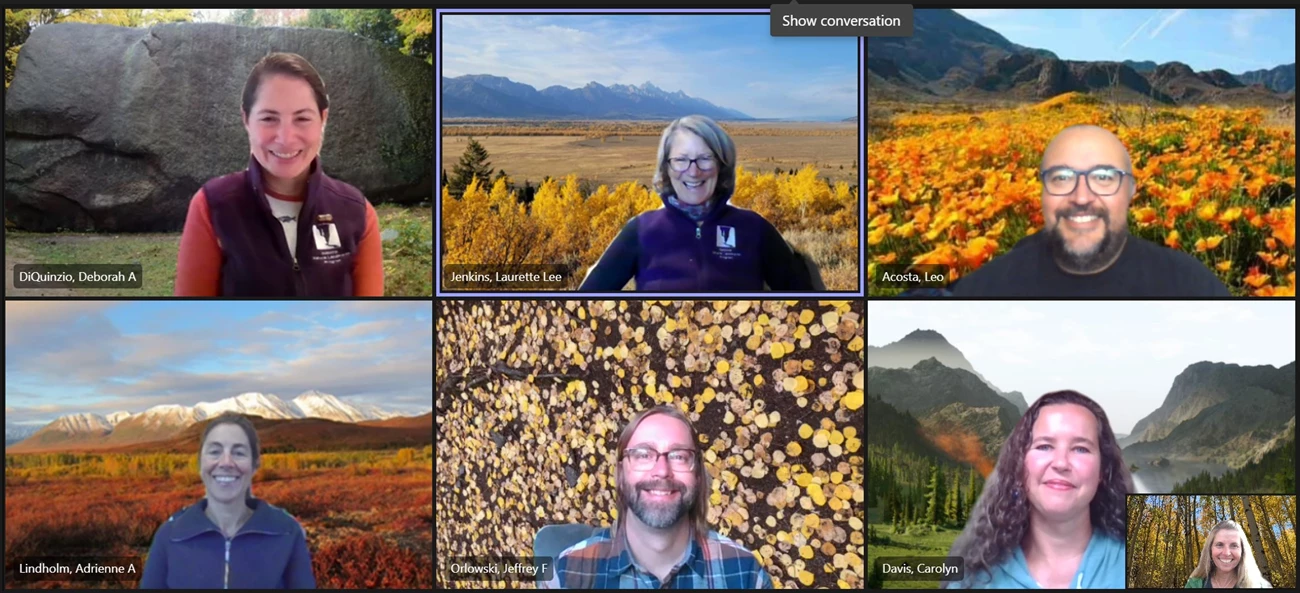
Part of a series of articles titled Landmark Highlights.
Previous: Landmark Highlights 2022
Next: Landmark Highlights 2020
Last updated: March 22, 2022